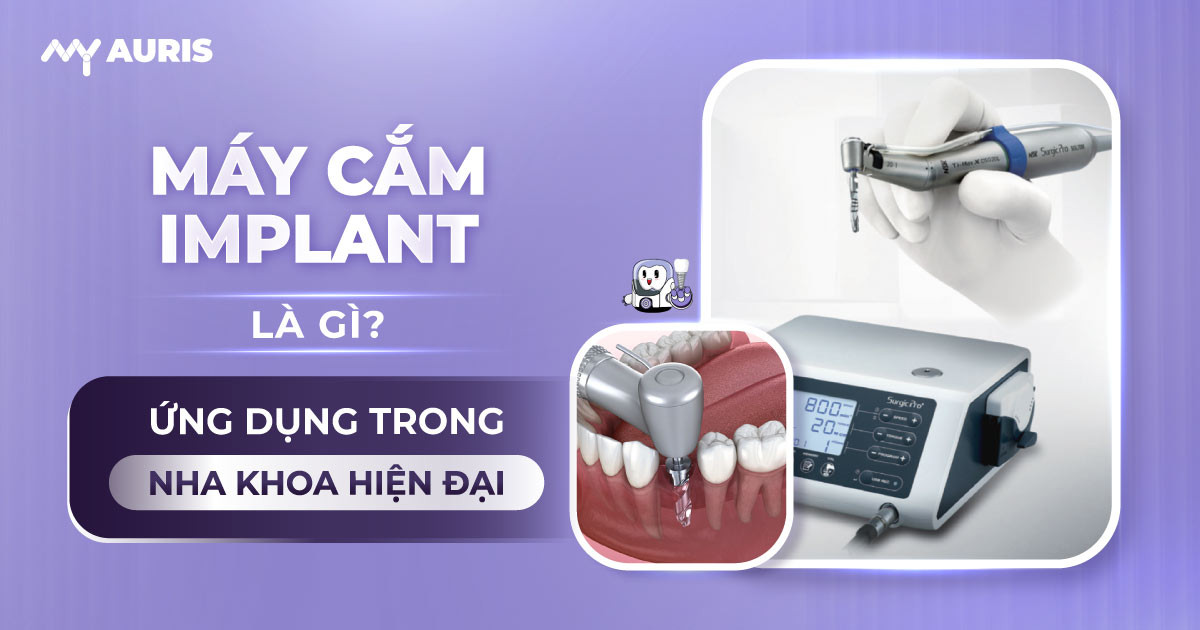Are you looking for information about implant placement devices? Choosing the right implant motor directly impacts the success of dental implant surgery. This article from My Auris provides comprehensive knowledge about implant placement machines, from technology and features to factors to consider when choosing one. We will guide you step-by-step, helping you better understand this crucial dental device.
What is an Implant Placement Machine?
An implant placement machine, also known as a dental implant motor or dental bone drill, is an essential dental medical device used in dental implant surgery. This device assists dentists in placing implant posts into the jawbone accurately, safely, and efficiently. It is an indispensable part of modern implant surgical systems and implant-assisted technologies. The implant placement machine helps the dental implant procedure proceed smoothly, minimizing invasiveness and shortening treatment time.
A complete dental implant system comprises several components, with the implant placement machine at its core. A dental implant motor typically includes:
Implant handpiece: Connects to the motor, transmitting power to drill the bone and place the implant post.
Implant peristaltic pump: Provides an irrigation system, cooling the surgical area and removing bone debris.
Control unit: Allows the dentist to adjust speed, torque, and implant placement modes. Some modern implant placement machines integrate intuitive 3D displays, implant-assisted technologies such as AI integration, and IoT connectivity.
Foot pedal: Secures the machine firmly, ensuring safety during operation.
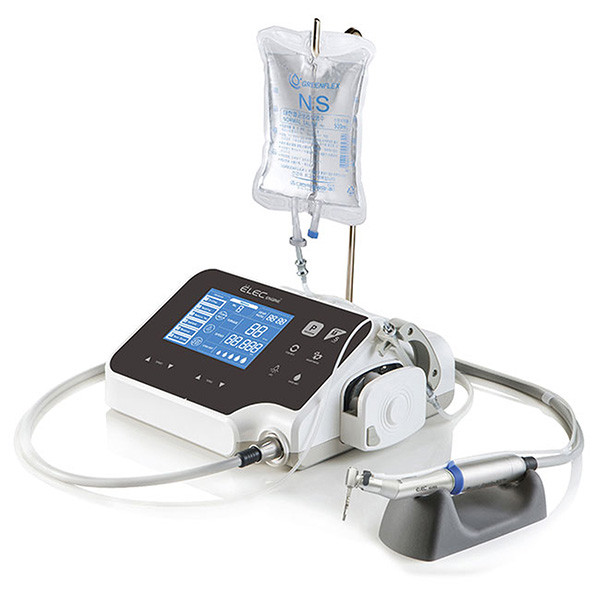
Comparison of Popular Implant Placement Machines
Choosing the right implant placement machine directly impacts the effectiveness of dental implant surgery. Dental equipment, dental surgical instruments, and dental implant systems are becoming increasingly advanced, requiring a deep understanding of dental technology.
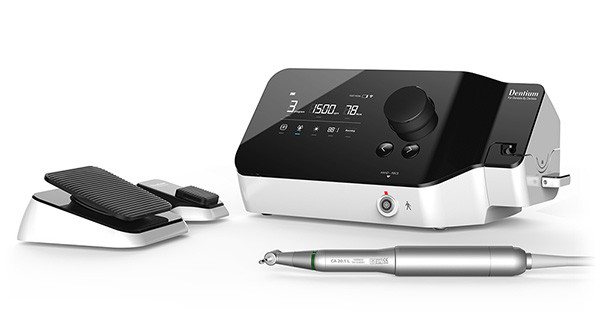
Dentium Implant Placement Machine: Advantages and Applications in Modern Dentistry
Dentium, a renowned implant machine manufacturer, provides high-quality implant placement devices. Dentium implant placement machines are favored for their powerful dental implant motor, efficient irrigation system, and connectivity with other implant-assisted systems.
Advantages of Dentium implant placement machines include an ergonomic design specifically for left-handed users, and a special vibration mode that reduces patient pain during periodontal surgery and dental restorations.
Dentium implant placement machines have diverse applications, ranging from simple to complex dental implant procedures, meeting the needs of dentists for non-invasive treatments. The price of Dentium implant placement machines is competitive, suitable for many dental clinics. This information assists dentists in selecting implant materials and placement procedures, as well as post-operative care.
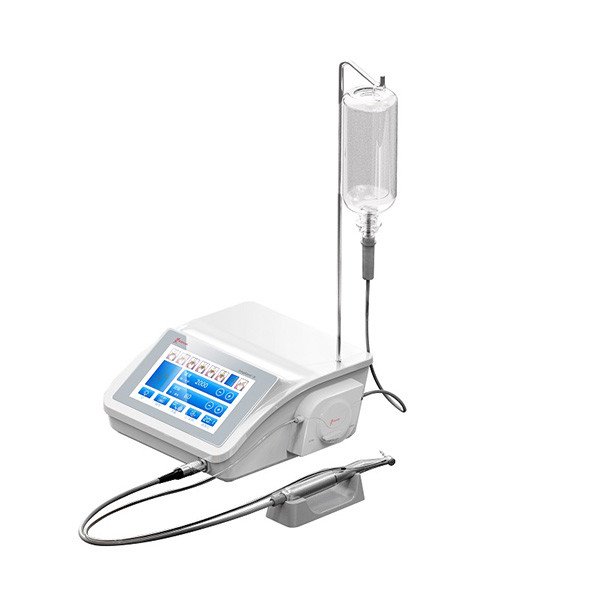
DTE Implant Placement Machine: Key Features and Economic Benefits
The DTE implant placement machine stands out for its affordability, offering economic benefits to clinics. DTE’s dental implant motor operates stably, ensuring high surgical performance. The precise implant handpiece gives dentists better control during placement. The integrated implant peristaltic pump helps control the amount of irrigation water, minimizing soft tissue damage. Its diverse implant placement modes are suitable for various implant posts, abutment connections, and prosthetic crowns. DTE is a reasonable choice for newly established dental clinics or those with limited budgets looking to invest in quality dental clinic equipment.
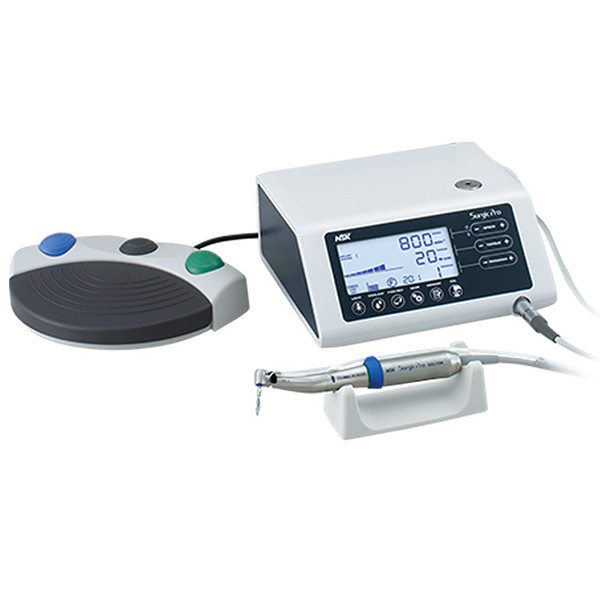
NSK Implant Placement Machine: Advanced Technology and Superior Durability
NSK is a renowned brand known for advanced dental technology. NSK implant placement machines are designed with superior durability, operating stably for extended periods. The machine features an intuitive 3D display, a powerful brushless motor, and an automatic stop function for overload, ensuring patient safety. An efficient cooling system helps maintain a stable temperature during surgery. Its excellent sterilization capability meets the stringent standards of dental medical equipment. NSK is a top choice for dental clinics demanding high technology and reliability.
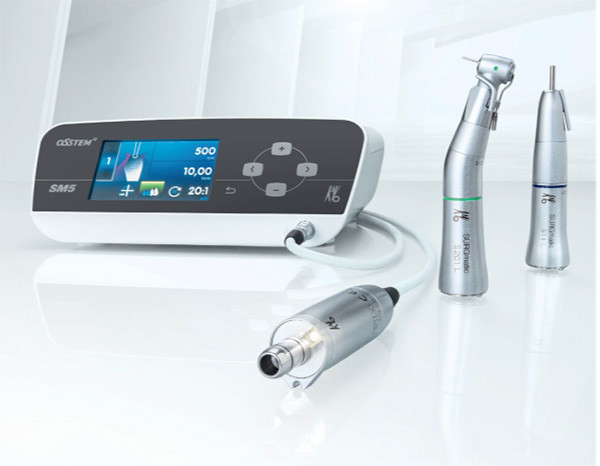
Osstem Implant Placement Machine: A Comprehensive Solution for Implant Placement
Osstem offers a comprehensive solution for dental implant placement, from implant materials and implant posts to implant placement machines. Osstem implant placement machines integrate pre-set libraries for various Osstem implant types, helping dentists easily select the appropriate mode. The intuitive, user-friendly interface shortens learning and familiarization time with the machine. Osstem is committed to product quality and professional customer support services. This is an ideal choice for dental clinics looking to use a complete Osstem implant system.
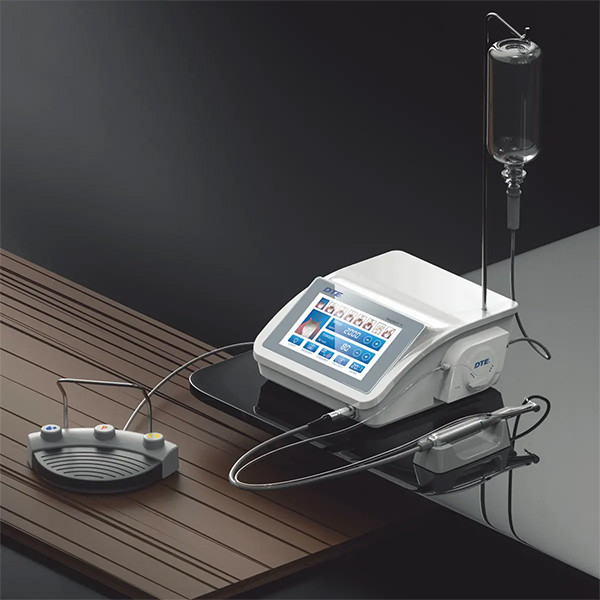
Woodpecker Implant Placement Machine: Compact Design and Stable Performance
Woodpecker is known for its compact design, saving space in dental clinics. Woodpecker implant placement machines offer stable surgical performance, meeting basic implant placement needs. Their reasonable price makes them suitable for small-scale dental clinics. The portable design is convenient for use in various surgical rooms. Woodpecker is a cost-effective choice that still ensures effective treatment.
Factors to Consider When Choosing an Implant Placement Machine
Carefully consider the following factors before deciding to invest in an implant placement machine:
Power, Speed, and Torque:
Determine your usage needs. The power, speed, and torque of the dental implant motor must meet the requirements for implant surgery, periodontal surgery, and dental restorations. A powerful dental bone drill is essential for dense, thick bone. Implant placement machines from Dentium, DTE, NSK, Osstem, and Woodpecker all offer models with different technical specifications. Thoroughly research the specifications before making a choice.
Cooling System and Sterilization Capability:
An efficient irrigation system ensures stable temperature during drilling, preventing bone damage. The sterilization capability of the implant handpiece, implant peristaltic pump, abutment connections, prosthetic crowns, and pilot drills is equally important. This prevents infection and ensures patient safety.
Implant-Assisted Technology:
Dental technology is rapidly advancing. Modern dental implant systems integrate many advanced features: IoT connectivity, AI integration, intuitive 3D displays, brushless motors, and automatic stop function for overload. Consider your needs and budget to choose the appropriate machine. For example, NSK machines are known for their advanced technology.
Design and Interface:
An ergonomic design, especially for left-handed users, helps dentists operate easily and precisely. An intuitive, user-friendly interface is also important. A compact, easily movable design is an advantage for clinics with limited space. Woodpecker machines are highly regarded for their compact design.
Price, Support Services, and Warranty:
Compare the prices of implant placement machines among manufacturers. Dentium and DTE generally offer more competitive prices. However, support services and warranty should also be considered. Implant placement modes and pre-set libraries for various implant types and implant posts are also important factors.
Compatibility with Existing Dental Clinic Equipment:
Ensure the implant placement machine is compatible with existing dental equipment, dental surgical instruments, tooth extraction machines, filling instruments, orthodontic devices, bone surgery machines, dental suction machines, surgical lights, dental chairs, and dental X-ray machines in the clinic. This avoids waste and optimizes operational efficiency.

Dental Implant Placement Procedure Using an Implant Placement Machine
Stage 1: Examination and Treatment Planning
In the first step, a dentist at the dental clinic will conduct a general examination and take dental X-rays to assess the condition of the jawbone, soft tissue, and missing tooth location. Based on the results, the dentist will develop a detailed treatment plan, select suitable implant materials, abutment connections, and prosthetic crowns, and determine the position, size, and number of implant posts to be placed. This process requires modern dental medical equipment such as dental X-ray machines and 3D imaging software. The dentist will discuss the implant placement procedure, post-operative care, and the cost of the implant placement machine with you.
Stage 2: Implant Placement Surgery
Implant placement surgery is performed in a sterile environment using a modern implant surgical system. The dentist will use a dental bone drill, implant handpiece, implant peristaltic pump, and irrigation system to create the space for implant post placement.
The precision of the implant placement machine (dental implant motor) with its pre-set implant placement modes, along with settings for various implant types, ensures that the implant post is placed in the correct position, depth, and desired angulation.
Stage 3: Healing and Abutment Connection
After implant placement, time is needed for the jawbone to integrate with the implant post. The healing period ranges from several weeks to several months, depending on oral health conditions and implant materials. During this stage, regular oral hygiene is crucial. Once the bone has fully integrated, the dentist will attach the abutment connection to the implant post, creating the foundation for the dental restoration.
Stage 4: Prosthetic Crown Attachment
Once the abutment connection is stable, the dentist will proceed with attaching the prosthetic crown. The prosthetic crown is custom-made to match the shape and color of natural teeth, providing high aesthetics. This non-invasive treatment method helps restore chewing function and aesthetics to the dentition.
What is the current price of an implant placement machine?
When choosing an implant placement machine, one of the unavoidable criteria for purchasing equipment is its price. According to Radon Vietnam statistics, the average price of an implant placement machine on the market ranges from 29 million to 100 million VND, depending on many specific factors. However, this is only a reference price. For the most accurate quotation, clinics should directly contact medical equipment suppliers for thorough, clear, and transparent consultation.
In reality, prices are not fixed because they are influenced by many related factors such as the origin of the implant placement machine, equipment source, brand, quality, and integrated features of the implant placement machine. Below are the main factors investors need to consider:
Origin, Source
Equipment can be manufactured domestically or imported directly from abroad. This leads to a clear price difference. Imported equipment is more expensive due to added shipping costs, customs fees, import taxes, etc. However, in return, you can own machinery with advanced technology and international standards.
Implant Placement Machine Brand
Currently, there are many brands of implant placement machines on the market, ranging from long-established renowned brands to emerging ones. Most investors will choose well-known brands to ensure high product quality, superior durability, and long-term warranty. Of course, this also means higher costs compared to other common product lines.
Quality
A machine with high quality, applying modern technology, robust construction, and many specialized functions will have a corresponding investment price. Equipment with international quality certifications often brings many benefits to clinics, ensuring operational performance, long-term durability, and absolute safety during use.
Features
Other useful features such as speed control, reverse mode, regular memory, software upgrades, and smart configurations all contribute to increasing the equipment’s value. Choosing a machine that suits the services offered by the clinic is important. In practice, a machine equipped with many features will support more flexible and precise implant placement, optimizing clinical treatment effectiveness.
Maintenance and Care of Implant Placement Machines to Extend Lifespan
Clean the implant placement machine after each use
After each dental implant surgery, cleaning the implant placement machine is the first and most crucial step. Use a specialized disinfectant solution for dental equipment to wipe down the dental implant motor, implant handpiece, implant peristaltic pump, and other components. Pay special attention to thoroughly cleaning the abutment connections and prosthetic crowns. Following the correct cleaning procedure helps remove implant materials, blood, and tissue, preventing infection and ensuring sterility for the next use.
Sterilize equipment according to regulations
Sterilization is an essential step to completely eliminate bacteria and viruses. Depending on the implant machine manufacturer (Dentium, DTE, NSK, Osstem, Woodpecker), you can use autoclaving or specialized disinfectant solutions for dental surgical instruments. Strictly follow the manufacturer’s instructions to ensure safety and effectiveness. Regularly check the irrigation system and ensure the irrigation water is always clean, meeting dental clinic standards.
Regular inspection and maintenance
Schedule regular inspections and maintenance for the implant placement machine. Dentists should check the Power, Speed, Torque, Cooling System, IoT connectivity, and AI integration of the machine. Ensure the dental implant motor and dental bone drill operate smoothly without unusual noises. Check implant placement modes and other functions such as the automatic stop function for overload and pre-set libraries for various implant types. Regular maintenance helps detect potential issues early, prevents severe damage, and extends the equipment’s lifespan. Contact the manufacturer or service center for professional technical support.
Proper storage of the implant placement machine
Store the implant placement machine in a dry, cool environment, away from direct sunlight. Use a specialized case to protect the machine from dust and impact. Avoid placing the implant placement machine near other dental medical equipment such as tooth extraction machines, filling instruments, orthodontic devices, bone surgery machines, dental suction machines, surgical lights, dental chairs, or dental X-ray machines to prevent interference or damage.


